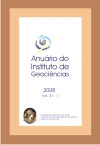Presence of the psammic cyanobacteria in the Lagoa Azul, Arraial do Cabo, Rio de Janeiro
DOI:
https://doi.org/10.11137/2008_1_24-29Abstract
The coastal area of the Rio de Janeiro State presents a series of lagoons, dune fields and strand plains, which are the result of the paleogeographical evolution during Neogene. The lagoa Azul is situated at 22º56'52"S and 42º04'62"W in the Arraial do Cabo, located about 160 km far the city of Rio de Janeiro. It is a natural hypersaline coastal aquatic body which, parallel to Atlantic Ocean. The present work focused on the identification of psammic cyanobacteria in the surface sediments of the lagoa Azul. The samples were obtained by using plastic tubes and were later aconditiones in opaque plastic containers and conserved in a 4% solution of formaldehyde. With the material obtained, permanent slides were prepared so as to characterize them phycologically. Qualitative analysis showed the presence of 14 species and the occurrence of the families Chroococcaceae Nägeli 1849 (5 sp.), Phormidiaceae Anagnostidis & Komárek 1988 (4 sp.), Synechococcaceae Komárek & Anagnostidis 1995 (2 sp.), Nostocaceae Kützing 1843 (1 sp.), Oscillatoriaceae Gomont 1892 (1 sp.) and Pseudanabaenaceae Anagnostidis & Komárek 1988 (1 sp.). The incidence of these species is also recorded in other lagoons (Araruama, Pernambuco, Pitanguinha and Vermelha) in the northeast of Rio de Janeiro coast, such as the frequency of cyanobacteria is justified by the harsh environment, without predation, with high salinity, elevated temperature and low concentration of oxygenDownloads
Download data is not yet available.
Downloads
Published
2008-01-01
How to Cite
Silva, L. H. da S. e (2008) “Presence of the psammic cyanobacteria in the Lagoa Azul, Arraial do Cabo, Rio de Janeiro”, Anuário do Instituto de Geociências. Rio de Janeiro, BR, 31(1), pp. 24–29. doi: 10.11137/2008_1_24-29.
Issue
Section
nd1569639953
License
This journal is licensed under a Creative Commons — Attribution 4.0 International — CC BY 4.0, which permits use, distribution and reproduction in any medium, provided the original work is properly cited.















